2017 MITSUBISHI iMiEV roof
[x] Cancel search: roofPage 31 of 296

Regular charging (charging method with rated AC 120 V outlet)
General information/Charging 3-17
3
N01216200019
Regular charge port light (A) comes on when the UNLOCK button on the remote control transmitter is pressed, or when any door orthe liftgate is opened.
The regular charge port
light and the dome light
s (with the dome light
switch in the “DOOR” position) will come onsimultaneously. However, the regular charge port light will not
come on when you press
the dome light (front) lens or slide the dome light (rear) switch to the “ON” position. For details, refer to
“Keyless entry system”
on page 5-5, “Dome
light (Front)/Reading
lights” on page 5-77 a
nd “Dome light (Rear)”
To turn on the charge port light again, press the UNLOCK button on the remote control transmitter, or open any
door or the liftgate.
Individuals using an
electro-medical
apparatus such as implantable pacemak-ers and implantable
cardiovascular-defi-
brillators should
check with the
manufacturer of the apparatus to confirm the effect of the el
ectromagnetic waves
from charging. The el
ectromagnetic waves
may affect the operations of the electro- medical apparatus. If you use an electro-medical apparatus, such as an implanta
ble cardiac pacemaker
or an implantable ca
rdiovascular
defibril-
lator, observe the following precautions before charging;• Keep your electro-medical apparatusaway from the charge connector, EVcharging cable, control box and regular charging station.• While regular charging;· Do not stay inside the vehicle. · Do not go inside the vehicle, for exam- ple to remove or place an item in the passenger compartment.· Do not open the liftgate, for example to remove or place an item in the cargo area.
To reduce the risk of electric shock, con- nect only to a prop
erly grounded and
waterproofed outlet. Never use an extension cable, multi-plug adapter or conversion adapter. Using them may cause overheating result- ing in fire.WA R N I N G
Never force the connection if the charging cable or plug shows damage or is not eas-ily connected due to foreign materialentering the plug or the outlet. Never use an outlet that is worn, damaged, or will not hold the plug firmly. Make sure that the plug is inserted all the way into the outlet before use. While it is normal fo
r the plug and charg-
ing cable to become warm during charg- ing, discontinue use immediately if the plug or charging cable becomes too hot totouch. Never pull the cable to remove the plug.Never connect or disconnect the plug with a wet hand.NOTE
Your vehicle is equipped with an EV charg- ing cable for regular charging. Refer to “EVcharging cable” on page 3-23. When connecting or
disconnecting the regu-
lar charge connector, in
sert/pull out the con-
nector straight. Also, do not incline or twist the connector.Doing so could cause a bad connection ormalfunction. Make sure to lock the doors to prevent theft, etc. during charging.WA R N I N G
Regular charge port light
A
BK0220401US.book 17 ページ 2015年6月3日 水曜日 午前7時42分
Page 33 of 296
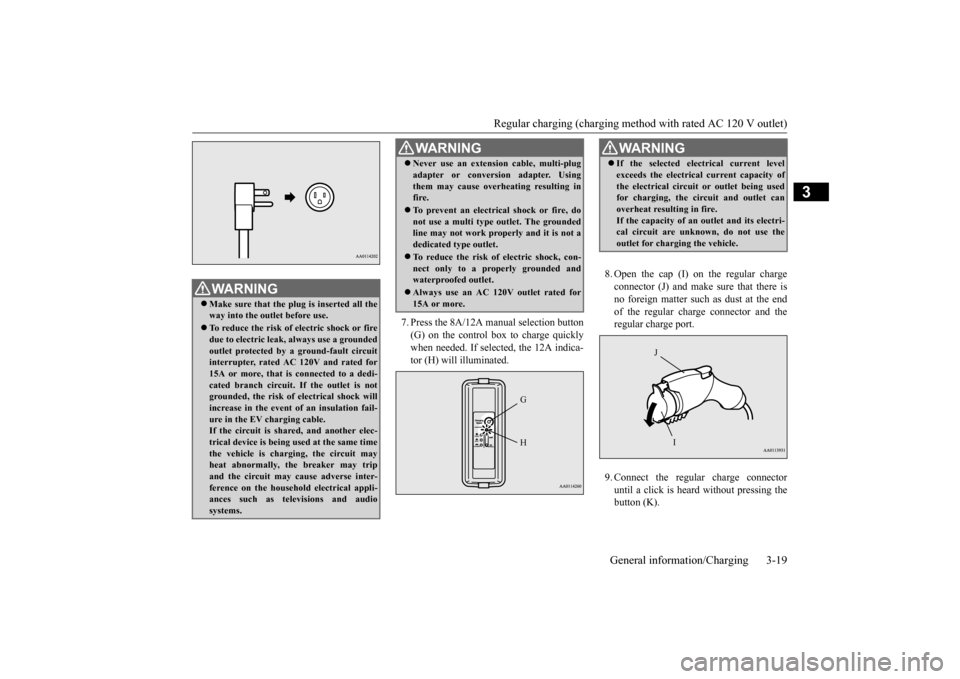
Regular charging (charging method with rated AC 120 V outlet)
General information/Charging 3-19
3
7. Press the 8A/12A manual selection button (G) on the control box to charge quickly when needed. If selected, the 12A indica-tor (H) will illuminated.
8. Open the cap (I) on the regular charge connector (J) and make sure that there is no foreign matter such as dust at the end of the regular charge connector and theregular charge port. 9. Connect the regular charge connector until a click is heard without pressing thebutton (K).
WA R N I N G Make sure that the plug is inserted all the way into the outlet before use. To reduce the risk of electric shock or fire due to electric leak,
always use a grounded
outlet protected by a
ground-fault circuit
interrupter, rated AC
120V and rated for
15A or more, that is connected to a dedi-cated branch circuit. If the outlet is not grounded, the risk of
electrical shock will
increase in the event of an insulation fail-ure in the EV charging cable. If the circuit is shar
ed, and another elec-
trical device is being
used at the same time
the vehicle is chargi
ng, the circuit may
heat abnormally, the breaker may trip and the circuit may cause adverse inter-ference on the household electrical appli- ances such as tele
visions and audio
systems.
Never use an extension cable, multi-plug adapter or conversi
on adapter. Using
them may cause over
heating resulting in
fire. To prevent an electric
al shock or fire, do
not use a multi type outlet. The grounded line may not work properly and it is not a dedicated type outlet. To reduce the risk of electric shock, con- nect only to a prop
erly grounded and
waterproofed outlet. Always use an AC 120V outlet rated for 15A or more.WA R N I N G
G H
WA R N I N G If the selected electrical current level exceeds the electrical current capacity ofthe electrical circuit
or outlet being used
for charging, the circuit and outlet can overheat resulting in fire. If the capacity of an outlet and its electri-cal circuit are unknown, do not use the outlet for charging the vehicle.
J
I
BK0220401US.book 19 ページ 2015年6月3日 水曜日 午前7時42分
Page 39 of 296
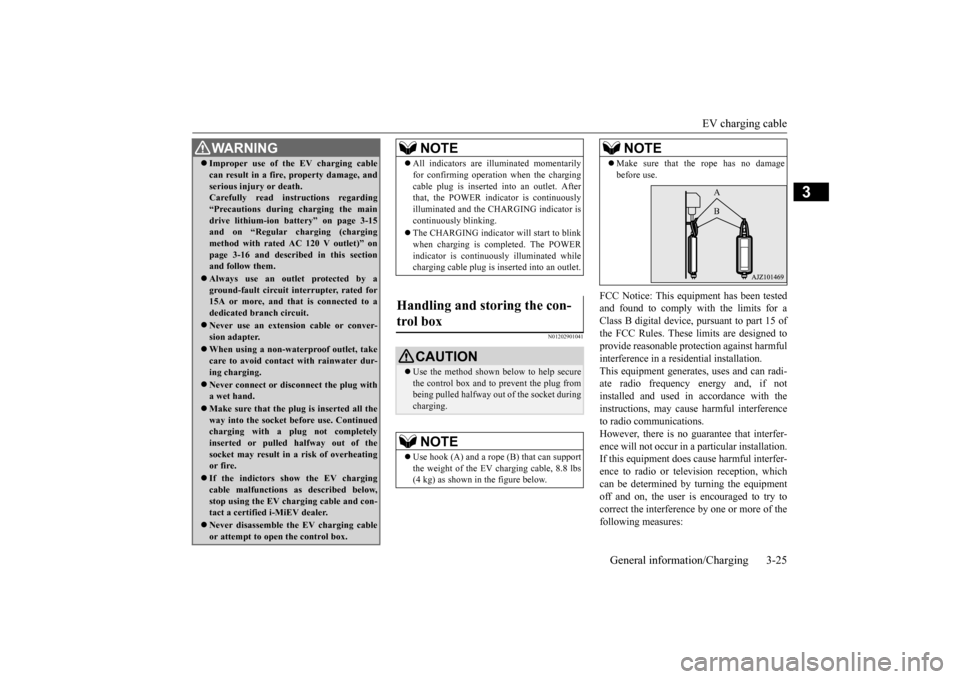
EV charging cable
General information/Charging 3-25
3
N01202901041
FCC Notice: This equi
pment has been tested
and found to comply with the limits for aClass B digital device,
pursuant to part 15 of
the FCC Rules. These limits are designed to provide reasonable prot
ection against harmful
interference in a residential installation. This equipment generates, uses and can radi- ate radio frequency energy and, if notinstalled and used in accordance with the instructions, may caus
e harmful interference
to radio communications.However, there is no guarantee that interfer- ence will not occur in a particular installation. If this equipment does
cause harmful interfer-
ence to radio or tele
vision reception, which
can be determined by turning the equipment off and on, the user is encouraged to try tocorrect the interference by
one or more of the
following measures:
WA R N I N G Improper use of the
EV charging cable
can result in a fire, property damage, andserious injury or death.Carefully read instructions regarding “Precautions during
charging the main
drive lithium-ion battery” on page 3-15and on “Regular charging (charging method with rated AC 120 V outlet)” on page 3-16 and describe
d in this section
and follow them. Always use an outlet protected by a ground-fault circuit interrupter, rated for 15A or more, and that
is connected to a
dedicated branch circuit. Never use an extension cable or conver- sion adapter. When using a non-wate
rproof outlet, take
care to avoid contact
with rainwater dur-
ing charging. Never connect or disconnect the plug with a wet hand. Make sure that the plug is inserted all the way into the socket before use. Continued charging with a plug not completely inserted or pulled
halfway out of the
socket may result in a risk of overheating or fire. If the indictors show the EV charging cable malfunctions as described below, stop using the EV charging cable and con-tact a certified i-MiEV dealer. Never disassemble the EV charging cable or attempt to open
the control box.
NOTE
All indicators are illuminated momentarily for confirming operation when the chargingcable plug is inserted into an outlet. Afterthat, the POWER indi
cator is continuously
illuminated and the CH
ARGING indicator is
continuously blinking. The CHARGING indicator will start to blink when charging is completed. The POWERindicator is continuous
ly illuminated while
charging cable plug is in
serted into an outlet.
Handling and storing the con- trol box
CAUTION Use the method shown below to help secure the control box and to prevent the plug from being pulled halfway out of the socket duringcharging.NOTE
Use hook (A) and a rope (B) that can support the weight of the EV charging cable, 8.8 lbs (4 kg) as shown in the figure below.
Make sure that the rope has no damage before use.NOTE
A B
BK0220401US.book 25 ページ 2015年6月3日 水曜日 午前7時42分
Page 101 of 296
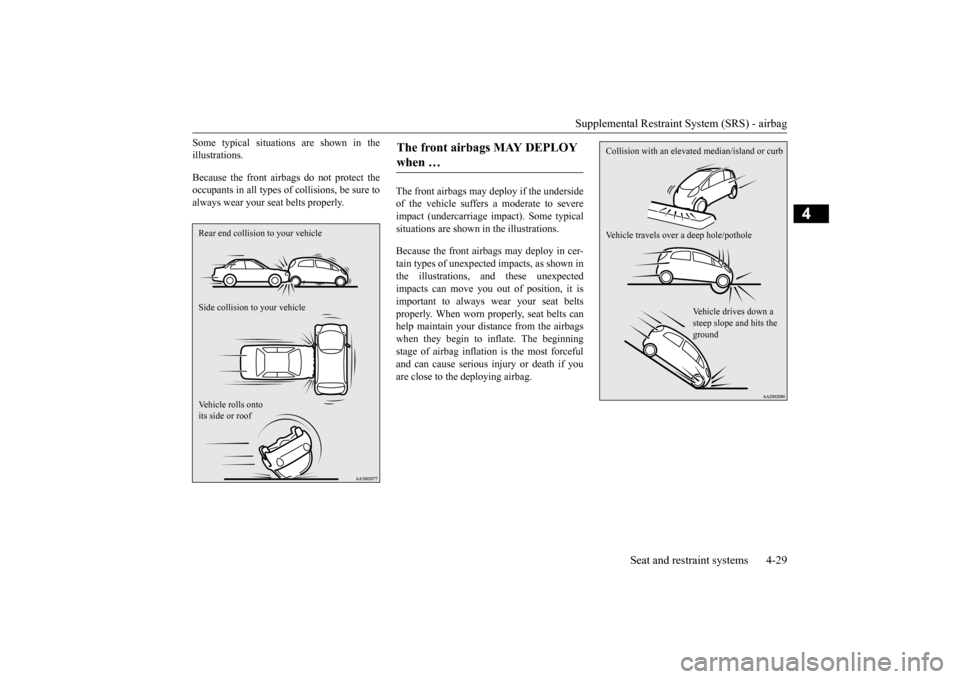
Supplemental Restraint System (SRS) - airbag
Seat and restraint systems 4-29
4
Some typical situations are shown in the illustrations. Because the front airbags do not protect the occupants in all types of collisions, be sure to always wear your seat belts properly.
The front airbags may deploy if the underside of the vehicle suffers a moderate to severe impact (undercarriage im
pact). Some typical
situations are shown in the illustrations. Because the front airb
ags may deploy in cer-
tain types of unexpected
impacts, as shown in
the illustrations, and these unexpected impacts can move you out
of position, it is
important to always wear your seat belts properly. When worn properly, seat belts canhelp maintain your distance from the airbags when they begin to inflate. The beginning stage of airbag inflation is the most forcefuland can cause serious injury or death if you are close to the deploying airbag.
Rear end collision to your vehicle Side collision to your vehicle Vehicle rolls onto its side or roof
The front airbags MAY DEPLOY when …
Collision with an elevated median/island or curb Vehicle travels over a deep hole/pothole
Vehicle drives down a steep slope and hits the ground
BK0220401US.book 29 ページ 2015年6月3日 水曜日 午前7時42分
Page 103 of 296
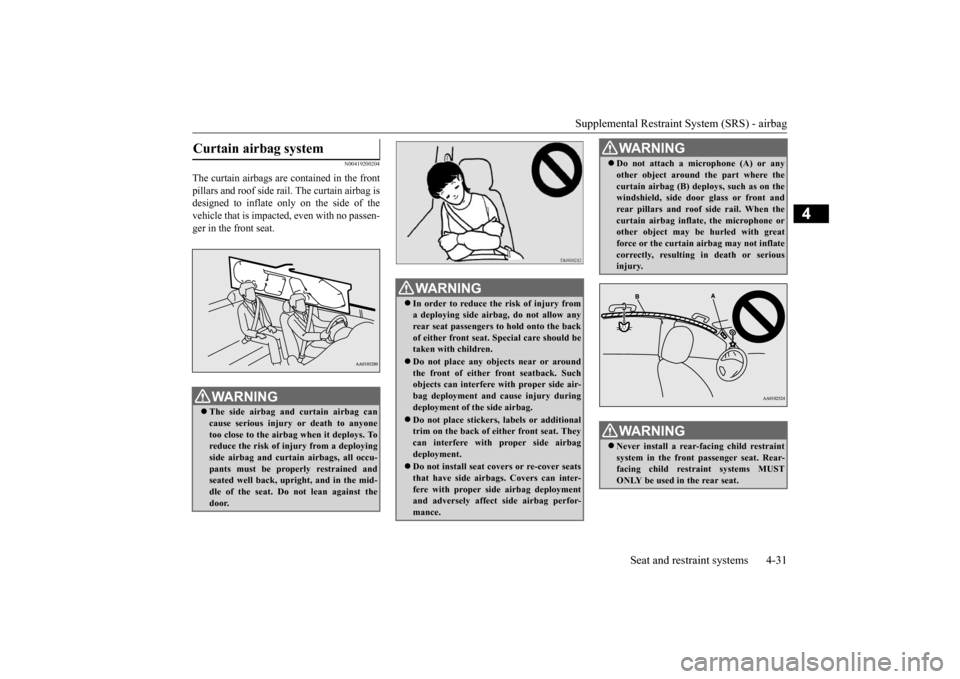
Supplemental Restraint System (SRS) - airbag
Seat and restraint systems 4-31
4
N00419200204
The curtain airbags are contained in the front pillars and roof side ra
il. The curtain airbag is
designed to inflate only on the side of thevehicle that is impacted
, even with no passen-
ger in the front seat.Curtain airbag system
WA R N I N G The side airbag and curtain airbag can cause serious injury
or death to anyone
too close to the airbag when it deploys. To reduce the risk of in
jury from a deploying
side airbag and curtai
n airbags, all occu-
pants must be properly restrained and seated well back, upright, and in the mid- dle of the seat. Do
not lean against the
door.
WA R N I N G In order to reduce the risk of injury from a deploying side airb
ag, do not allow any
rear seat passengers to hold onto the back of either front seat. Special care should betaken with children. Do not place any objects near or around the front of either front seatback. Such objects can interfere with proper side air- bag deployment and cause injury duringdeployment of the side airbag. Do not place stickers,
labels or additional
trim on the back of either front seat. They can interfere with proper side airbag deployment. Do not install seat c
overs or re-cover seats
that have side airbag
s. Covers can inter-
fere with proper si
de airbag deployment
and adversely affect
side airbag perfor-
mance.
Do not attach a microphone (A) or any other object around the part where thecurtain airbag (B) depl
oys, such as on the
windshield, side door glass or front and rear pillars and roof
side rail. When the
curtain airbag inflate,
the microphone or
other object may be
hurled with great
force or the curtain airbag may not inflate correctly, resulting in death or seriousinjury. WA R N I N G Never install a rear-facing child restraint system in the front passenger seat. Rear- facing child restraint systems MUST ONLY be used in the rear seat.WA R N I N G
BK0220401US.book 31 ページ 2015年6月3日 水曜日 午前7時42分
Page 105 of 296
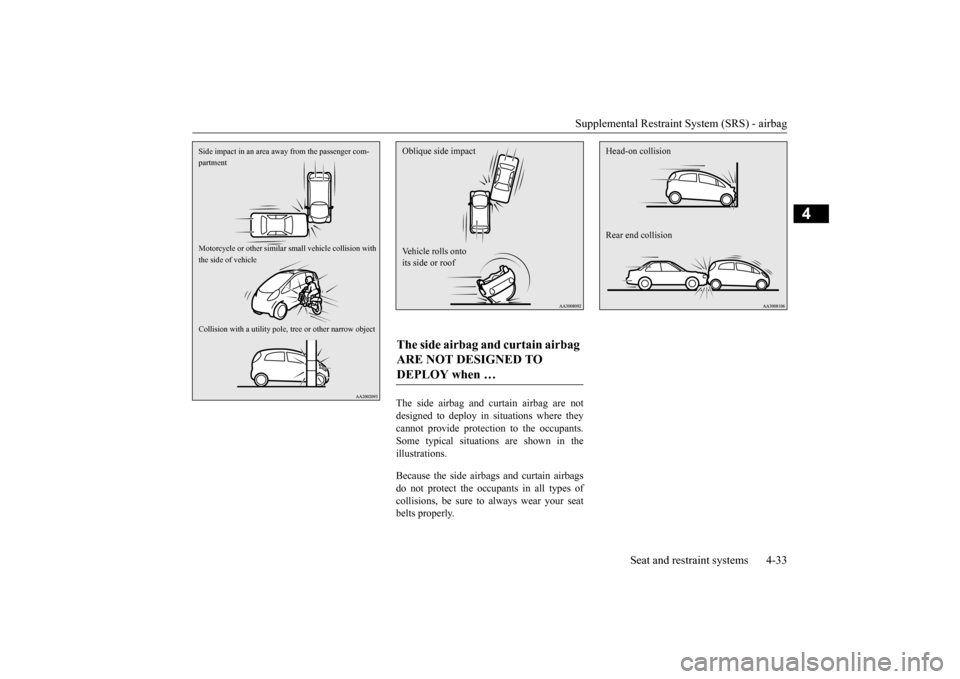
Supplemental Restraint System (SRS) - airbag
Seat and restraint systems 4-33
4
The side airbag and curtain airbag are not designed to deploy in situations where theycannot provide protectio
n to the occupants.
Some typical situations are shown in the illustrations. Because the side airbags and curtain airbags do not protect the occ
upants in all types of
collisions, be
sure to always wear your seat
belts properly.
Side impact in an area away from the passenger com- partment Motorcycle or other similar
small vehicle collision with
the side of vehicle Collision with a utility pole,
tree or other narrow object
The side airbag and curtain airbag ARE NOT DESIGNED TO DEPLOY when … Vehicle rolls onto its side or roof
Head-on collision Rear end collision
BK0220401US.book 33 ページ 2015年6月3日 水曜日 午前7時42分
Page 106 of 296
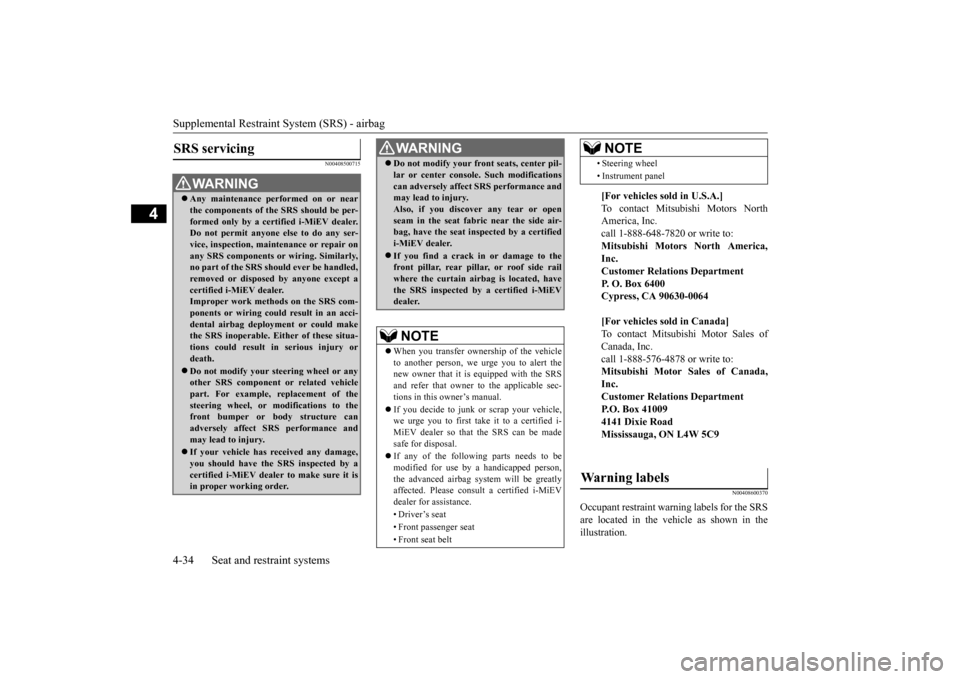
Supplemental Restraint System (SRS) - airbag 4-34 Seat and restraint systems
4
N00408500715
N00408600370
Occupant restraint warn
ing labels for the SRS
are located in the vehicle as shown in the illustration.
SRS servicing
WA R N I N G Any maintenance performed on or near the components of the SRS should be per-formed only by a certified i-MiEV dealer. Do not permit anyone else to do any ser- vice, inspection, main
tenance or repair on
any SRS components or
wiring. Similarly,
no part of the SRS should ever be handled, removed or disposed
by anyone except a
certified i-MiEV dealer. Improper work methods on the SRS com- ponents or wiring could result in an acci-dental airbag deploym
ent or could make
the SRS inoperable. Ei
ther of these situa-
tions could result in serious injury ordeath. Do not modify your steering wheel or any other SRS component
or related vehicle
part. For example, replacement of the steering wheel, or modifications to thefront bumper or body structure can adversely affect SR
S performance and
may lead to injury. If your vehicle has re
ceived any damage,
you should have the
SRS inspected by a
certified i-MiEV dealer to make sure it is in proper working order.
Do not modify your front seats, center pil- lar or center console. Such modificationscan adversely affect
SRS performance and
may lead to injury. Also, if you discove
r any tear or open
seam in the seat fabr
ic near the side air-
bag, have the seat in
spected by a certified
i-MiEV dealer. If you find a crack in
or damage to the
front pillar, rear pillar, or roof side rail where the curtain airbag is located, havethe SRS inspected by a certified i-MiEV dealer.NOTE
When you transfer ownership of the vehicle to another person, we
urge you to alert the
new owner that it is
equipped with the SRS
and refer that owner to
the applicable sec-
tions in this owner’s manual. If you decide to junk or scrap your vehicle, we urge you to first take it to a certified i- MiEV dealer so that the SRS can be madesafe for disposal. If any of the following parts needs to be modified for use by
a handicapped person,
the advanced airbag sy
stem will be greatly
affected. Please consult a certified i-MiEV dealer for assistance. •Driver’s seat • Front passenger seat • Front seat beltWA R N I N G
• Steering wheel • Instrument panel[For vehicles sold in U.S.A.] To contact Mitsubishi Motors North America, Inc.call 1-888-648-7820 or write to: Mitsubishi Motors North America, Inc.Customer Relations Department P. O. Box 6400 Cypress, CA 90630-0064 [For vehicles sold in Canada] To contact Mitsubishi Motor Sales ofCanada, Inc. call 1-888-576-4878 or write to: Mitsubishi Motor Sales of Canada,Inc. Customer Relations Department P.O. Box 410094141 Dixie Road Mississauga, ON L4W 5C9
Warning labels
NOTE
BK0220401US.book 34 ページ 2015年6月3日 水曜日 午前7時42分
Page 197 of 296

Loading information Driving safety 6-7
6
It is important to famil
iarize yourself with the
following terms before loading your vehicle: Vehicle maximum load on the tire: load on an individual tire that is determined bydistributing to each axle its share of the maximum loaded vehicle weight and dividing by two. Vehicle normal load on the tire: load on an individual tire that is determined by dis- tributing to each axle its share of the curbweight, accessory weight, and normal occupant weight and dividing by two. Maximum loaded vehicle weight: the sum of - (a) Curb weight; (b) Accessory weight;(c) Vehicle capacity weight; and (d) Production options weight. Curb weight: the weight of a motor vehi- cle with standard e
quipment including the
maximum capacity of oil, and coolant.
Accessory weight: the combined weight (in excess of those st
andard items which
may be replaced) of automatic transmis- sion, power steering, power brakes, power windows, power seats,
radio, and heater,
to the extent that these items are available as factory- installe
d equipment (whether
installed or not). Vehicle capacity weight: the rated cargo and luggage load plus 150 lbs (68 kg)
*
times the vehicle’s designated seating capacity. Production options weight: the combined weight of those installed regular produc- tion options weighing over 5 lbs (2.3 kg) in excess of those standard items whichthey replace, not prev
iously considered in
curb weight or accessory weight, includ- ing heavy duty brakes,
ride levelers, roof
rack, heavy duty battery, and special trim. Normal occupant weight: 150 lbs (68 kg)
*
times the number of specified occupants.(In your vehicle the number is 2) Occupant distributi
on: distribution of
occupants in a vehicle as specified. (Inyour vehicle the distribution is 2 in front seat)
N00630100370
The tire and loading information placard is located on the driver’s door sill. This placard shows the maximum number of occupants permitted to
ride in your vehicle as
well as “the combined
weight of occupants
and cargo” (C), which
is called the vehicle
capacity weight. This
placard also tells you
the size and recomme
nded inflation pressure
for the original equipment tires on your vehi-cle. For more information, refer to “Tires” on page 9-10.
WA R N I N G Never overload your ve
hicle. Overloading
can damage your vehicl
e, adversely affect
vehicle performance, including handlingand braking, cause tire failure, and result in an accident.
* : 150 lbs (68 kg) is the weight of one per- son as defined by U.S.A. and Canadian regulations.
Tire and loading information placard
BK0220401US.book 7 ページ 2015年6月3日 水曜日 午前7時42分